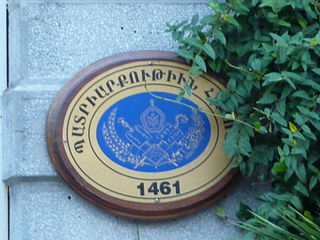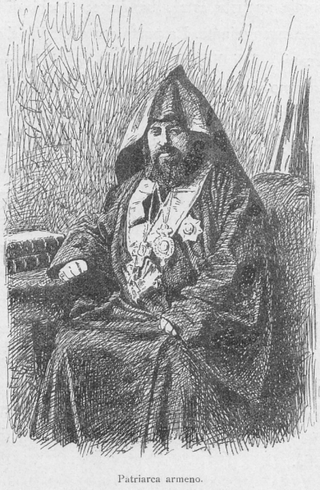This is the list of cathedrals in Turkey sorted by denomination.
Contents

This is the list of cathedrals in Turkey sorted by denomination.


Cathedrals of the Catholic Church in Turkey: [1]


An exarch was the holder of any of various historical offices, some of them being political or military and others being ecclesiastical.

Fener is a quarter midway up the Golden Horn in the district of Fatih in Istanbul, Turkey. The Turkish name is derived from the Greek word "phanarion", meaning lantern, streetlight or lamppost; the neighborhood was so called because of a column topped with a lantern which stood here in the Byzantine period and was used as a street light or lighthouse.

The Melkite Greek Catholic Church, or Melkite Byzantine Catholic Church, is an Eastern Catholic church in full communion with the Holy See as part of the worldwide Catholic Church. Its chief pastor is Patriarch Youssef Absi, headquartered at the Cathedral of Our Lady of the Dormition in Damascus, Syria. The Melkites, who are Byzantine Rite Catholics, trace their history to the early Christians of Antioch, formerly part of Syria and now in Turkey, of the 1st century AD, where Christianity was introduced by Saint Peter.

The Catholic Church in Egypt is considerably small as compared to the rest of the Christian population in Egypt, which is a significant minority among Muslims. The Catholic population in Egypt is said to have begun during the British control of Egypt. However, many emigrated after the 1952 Revolution in Egypt, which also caused the overthrow and exile of King Farouk of Egypt. Catholics in Egypt belong to seven distinct ritual Particular Churches sui iuris, the largest being the Coptic Catholic Church, led by its Patriarch of Alexandria.

The Armenian Patriarchate of Constantinople is an autonomous see of the Armenian Apostolic Church. The seat of the Armenian Patriarchate of Constantinople is the Surp Asdvadzadzin Patriarchal Church in the Kumkapı neighborhood of Istanbul.

The Armenian Patriarch of Constantinople, also known as Armenian Patriarch of Istanbul, is today head of the Armenian Patriarchate of Constantinople, one of the smallest Patriarchates of the Oriental Orthodox Churches but one that has exerted a very significant political role and today still exercises a spiritual authority.

Alphabetical list of Eastern Christianity-related articles on English Wikipedia

The Greek Byzantine Catholic Church or the Greek-Catholic Church of Greece is a sui iuris Eastern Catholic particular church of the Catholic Church that uses the Byzantine Rite in Koine Greek and Modern Greek. Its membership includes inhabitants of Greece and Turkey, with some links with Italy and Corsica.

The Catholic Church in Turkey is part of the worldwide Catholic Church, under the spiritual leadership of the Pope and the canonical leadership of the curia in Rome that is submitted to the Pope.

The Catholic Church in Syria is part of the worldwide Catholic Church, under the spiritual leadership of the Pope in Rome.
Christianity in Turkey has a long history dating back to the early origins of Christianity in Asia Minor during the 1st century AD. In modern times the percentage of Christians in Turkey has declined from 20 to 25 percent in 1914 to 3–5.5 percent in 1927, to 0.3–0.4%, roughly translating to 200,000–320,000 devotees. The percentage of Christians in Turkey fell mainly as a result of the late Ottoman genocides: the Armenian genocide, Greek genocide, and Assyrian genocide, the population exchange between Greece and Turkey, the emigration of Christians that began in the late 19th century and gained pace in the first quarter of the 20th century, and due to events such as the 1942 Varlık Vergisi tax levied on non-Muslim citizens in Turkey and the 1955 Istanbul pogrom against Greek and Armenian Christians. Exact numbers are difficult to estimate as many former Muslim converts to Christianity often hide their Christian faith for fear of familial pressure, religious discrimination, and persecution.

The Patriarchate of Cilicia is an ecclesiastical jurisdiction and the only patriarchate of the Armenian Catholic Church of the Catholic Church. The territorial jurisdiction of the Patriarch of Cilicia is the Archeparchy of Beirut, over which the Patriarch of Cilicia holds ordinary authority. The St. Elie and St. Gregory the Illuminator Armenian Catholic Cathedral in Beirut, Lebanon, is the cathedra of the Patriarchate. The Patriarchate is headed by Patriarch Raphaël Bedros XXI Minassian elected in September 2021.

The Armenian Catholic Archeparchy of Istanbul, also known as Armenian Catholic Archdiocese of Constantinople, serves Armenian Catholics in Turkey and is under the Armenian Catholic Patriarch of Cilicia. Its cathedral is St. Mary of Sakızağaç Cathedral in Istanbul.
Patriarchate of Constantinople generally refers to the Ecumenical Patriarchate of Constantinople, the seniormost authority in the Eastern Orthodox Church, led by the Ecumenical Patriarch of Constantinople. The diocese of Constantinople is alleged to have originated with Andrew the Apostle's visit in 38, and has been formally designated as Patriarchate since 531. Its seat is the city successively known as Byzantium, Constantinople, and now Istanbul, Turkey.

The St. Mary of Sakızağaç Cathedral also called Surp Asdvadzadzin, or the Armenian Catholic Cathedral of Istanbul is a cathedral belonging to the Armenian Catholic Church, which follows the Armenian rite and is in full communion with the Pope. It is located in Istanbul, the largest city in the Eurasian country of Turkey. It is not to be confused With the other two Catholic cathedrals in that same locality, the Cathedral of the Holy Spirit, which follows the Latin Rite, and the cathedral of the Greek Catholic rite.
Holy Trinity Greek Catholic Cathedral in Istanbul, also called Holy Trinity Rum Catholic Church, is the cathedral of the Greek Byzantine Catholic Church in Istanbul, Turkey. It is located on Hamalbaşı Caddesi in the Beyoğlu district of Istanbul and is currently used as a church for the local Chaldean Catholic community.